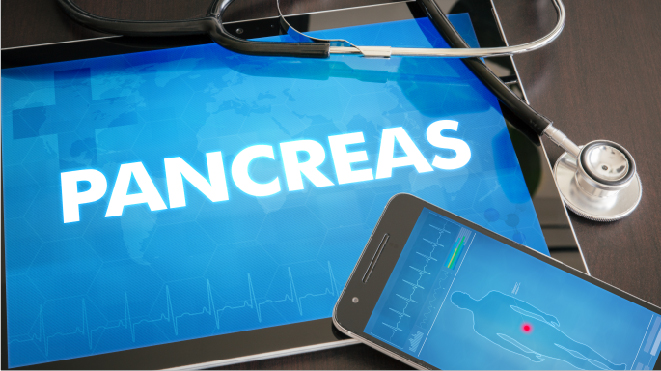Pancreatic cancer in the endocrine part of the pancreas are far less common than those of exocrine part and are called pancreatic neuroendocrine tumours. The endocrine part of the pancreas is responsible for secretion of hormones into the bloodstream while the exocrine part is responsible for releasing enzymes into ducts. These tumours can be benign or cancerous.
Types of pancreatic neuroendocrine tumours:
An important factor for determining the outlook is if the tumour is functioning (which means it is making hormones) or non-functioning. If in case the tumour is functional, the type of hormone can also be important. There are five main types of functioning tumours depending on the hormone they release, though it is possible for the tumour to release more than one hormone also.
Gastrinoma:
The tumour produces too much of gastrin, a hormone that causes acid production in stomach. High amounts of gastrin leads to stomach ulcers and can also cause Zollinger Ellison syndrome. Some of the symptoms of gastrinoma are stomach ulcers, pain in the stomach, back pain, diarrhea etc.
Insulinoma:
Insulin is a hormone that helps convert glucose into energy and it regulates the level of blood sugar in the body. When the tumour makes too much insulin, it causes low blood sugar, a condition termed hypoglycemia. Insulinomas can be non cancerous too. Blurred vision, feeling light headed, hungry, thirsty, tired or weak are some of the symptoms of insulinoma.
Glucagonoma:
Glucagon converts the stored glycogen into glucose releasing the glucose into the blood. If the neuroendocrine tumour makes glucagon, the blood sugar level rises and the condition is called hyperglycemia. Skin rash on face, stomach and legs, blood clot in the lungs or in the arms or legs, headaches, frequent urination, dry skin etc are some of the common symptoms.
VIPoma:
Vasoactive Intestinal peptide is a hormone that stimulates the absorption of salts and water in the small intestine. Increase in VIP production can cause diarrhea and can also lead to Verner Morrison syndrome. Diarrhea, dehydration, dry skin or mouth, headaches, dizziness, low levels of potassium in the body, cramps or abdominal pain and unexplained weight loss are some of the symptoms of VIPoma.
Somatostatinoma:
Somatostatin is a hormone that regulates the production of other hormones such as growth hormone, insulin, gastrin etc and controls rapid cell reproduction. In somatostatinoma, the tumours make somatostatin excessively. Some symptoms of this type of tumour are high blood sugar, frequent urination, dry skin, headaches, feeling thirsty, hungry, or weak, gallstones, yellowing of skin and unexplained weight loss.
Staging:
Staging is an important step to understand the severity and spread of cancer and hence in determining the treatment options and to know the survival rates and outlook. Pancreatic neuroendocrine tumours are staged similar to pancreatic endocrine cancers using the TNM system which stands for Tumour, Node and Metastasis. Read more about the TNM method of staging here
The actual demarcation of stages however differs slightly.
Stage 1:
The tumour is less than 2 cm and is still in the pancreas and has not spread to distant organs. The stage grouping is (T1, N0, M0)
Stage 2:
The tumour is 2 to 4 cm in size and is still in the pancreas or has spread to duodenum and common bile duct. The cancer in this stage has not spread to the lymph nodes or other parts of the body.
Stage 3:
The tumour has spread to the nearby organs like stomach, spleen, colon etc, or has spread into lymph nodes but has not spread to distant parts of the body.
Stage 4:
The tumour can be of any size and may or may not have spread to the lymph nodes but has spread to distant parts of the body.
Treatment:
The treatment of pancreatic neuroendocrine tumours mainly depends on whether or not the tumours are resectable, though these tumours are more likely to be resectable than exocrine pancreatic cancers.
For resectable tumours, surgery is the best option and usually that alone suffices. The exact procedure depends on the size, location and the type of tumour. Read more about surgery for pancreatic cancer treatment here
For unresectable tumours, surgery alone will not be enough and doctors might suggest chemotherapy or radiotherapy. Chemotherapy may be needed in case of poorly differentiated tumours too.
Survival Rates:
The metric for survival rate is the five year survival rate that shows which shows how many people out of hundred with a certain cancer live five years after diagnosis. The survival statistics for patients with PNET are available by stage only if they were subjects to surgery.
Based on the data from 1985 to 2004:
The survival rate for people with stage 1 is about 61%, that of stage 2 is 52%, followed by 41% and 16% for stages 3 and 4 respectively. Early detection improves the chances of the patient, as evident from the statistics. The overall survival rate of patients who did not go for surgery was noted to be around 16%.




